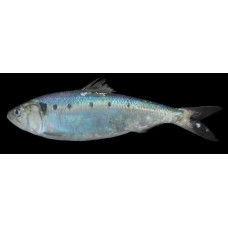Latin name
Sprattus sprattus
Other names
Bristling, brisling, garvie, garvock, Russian sardine, russlet, skipper or whitebait.
Identification
Characterised by strongly developed keel-shaped scales. The keel extends from the throat to the anal fin, and the belly is compressed from the sides.
Distribution
Inhabits the Baltic and Black Seas, also in the North and Norwegian Seas.
Habitat
Pelagic, gregarious fish. Usually found in schools near the shore, sometimes entering estuaries (especially juveniles) and tolerating salinity up to 4 ppb.
Size
The average size of commercially caught fish is 6-13 centimetres, but there are specimens 13-15 centimetres long.
Life history and Behavior
Shows strong migrations between winter feeding grounds and summer spawning grounds. Rises to the surface at night.
Food and feeding habits
The diet consists mainly of planktonic crustaceans (zooplankton) and fry.
Reproduction
It spawns between May and August. She lays her eggs at a depth of 10-20 m and produces 6000-14000 pelagic eggs. Juveniles drift close to the shore.
| Classification | |
| Phylum | Chordata |
| Class | Actinopterygii |
| Squad | Clupeiformes |
| Family | Clupeidae |
| Genus | Sprattus |
| Species | S. sprattus |
| Features | |
| Conservation status | Least Concern |
| Habitat | Pelagic |
| Life span, years | 6 |
| Maximum body weight, kg | 0,012 |
| Maximum length, cm | 15 |
| Threat to people | Edible |
| Way of eating | Predator |
European sprat
Tags: european sprat


